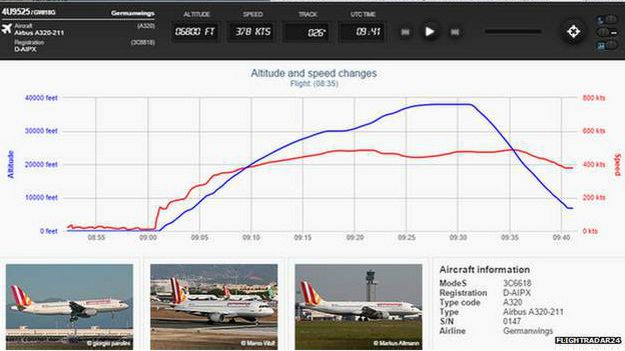Germanwings flight.
Thank you for the intelligent and detailed response to the FACTS of the situation, and not mindlessly jumping to conclusions as others would have us do. I appreciate the information.
Or you could just jump to conclusions without considering ANY of the facts, sure.
The plane was set up on a descent to lose ~3,500 to 4,000 feet per minute. While fairly steep, it's very controllable. In fact, it's a descent profile that's inline with something pilots would intentionally set if there was a cabin pressure change or problem.
The decrease in altitude began just a couple minutes after reaching peak cruising altitude at 38,000 feet. Also known as the point when the pressure outside the plane and inside the plane would have been at the highest gradient.
The altitude of the plane decreased until ~10,000 feet, leveled off slightly, and then decreased slightly again. All while the airspeed remained relatively constant, and then decreased slightly. The airspeed on that graph is in red, and the axis scale is fairly narrow, so that speed decrease is not substantial or dangerous by itself. The final decrease in speed is also when the plane is still descending, and only took the plane down to 380 kts, which is still plenty fast. The altitude dropped over 30,000 feet, but the speed never wavered by more than 100 kts. In fact, during the first 20,000 feet of descent the speed didnt change more than 20 kts. What does all that mean? It was a controlled decent, by someone that knew how to do it. Not kinda knew how to do it, but really knew how to do it.
If you just nose it into the ground, you dump altitude and GAIN airspeed. Lots of it. If you're fighting for control, your flight profile doesn't look like that. If you're trying to auger the plane into the mountains, your flight profile doesn't look like that. Why the heck would you set a descent that will take over 8 minutes if your goal is to crash the plane? That's just 8 minutes for someone to change the course of events. Even you lost ALL power in an A320, your glide slope doesn't even look like that. A non-power glide with trim for max altitude in an A320 is closer to a 1,500 ft/min descent, A320's are pretty efficient aircraft.
Its all up to the data recorder and flight deck recorder now. The lack of a distress call is unusual, but not unheard of. Your training tells you to make the call, but your instinct is to deal with the issues at hand. And if the issue at hand is dire it could involve everyone on the flight deck, and task saturation sometimes means that call doesn't get made. The descent looks like a response to a cabin pressure or cabin atmosphere issue. And the continued descent below a safe altitude, while obviously tragic, would also fit with a crew that was struggling with cabin pressure or atmosphere issues, like oxygen deprivation, smoke inhalation, etc. Or a mechanical issue causing the plane to lose altitude.
There are obviously a lot of possibilities, and I'm sure there will be a thorough investigation of all of them. But quite possibly the ONE thing that flight profile DOESN'T look like is terrorism. What it does look like is a trained response to a mechanical issue, after which the crew either lost awareness of either the plane's or the terrain's altitude, lost avionics on the terrain, or were simply unable to do anything further about it.
Regardless, it's a tragedy for all of those families. And it has been a lousy year in the commercial aviation world.
This is a larger version of the graph. It's a from a flight tracking website called FlightRadar24, which tracks civil aviation flights throughout the world. Also, not as accurate as the information that will come from the plane. You can actually see an interactive version here, which will link the altitude and flight speed in the readout. http://www.flightradar24.com/data/airplanes/d-aipx/#5d42675

Thank you for the intelligent and detailed response to the FACTS of the situation, and not mindlessly jumping to conclusions as others would have us do. I appreciate the information.